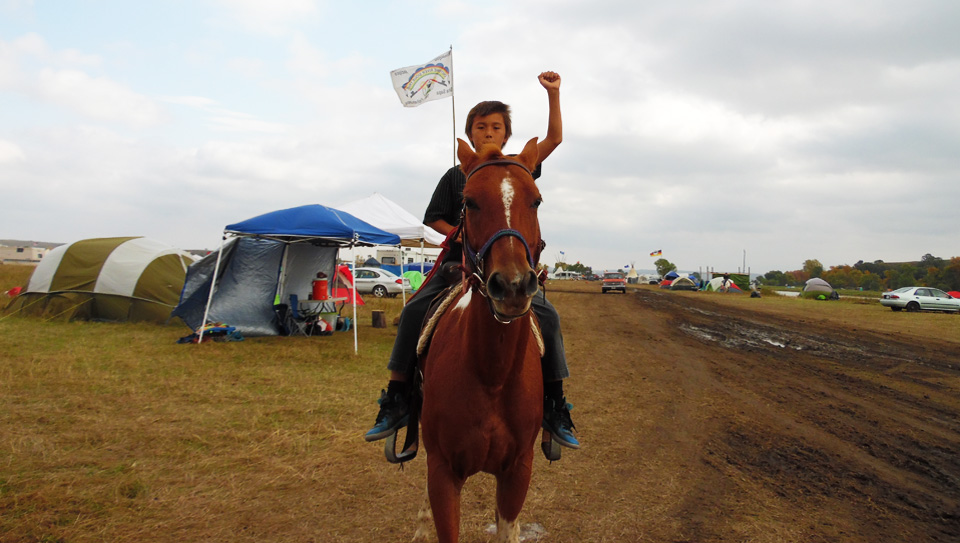
SACRED STONE CAMP, N.D. — As several of us from Chicago approached the camp that is now known around the world, we saw the flags of many Native tribes, tents, tepees, makeshift buildings, horses and motor vehicles spread across a valley near where the Missouri and Cannonball Rivers come together.
The Sacred Stone encampment, as it is called by the thousands protesting here on any given day, is near the Standing Rock Sioux reservation.
It is a place where Native tribes from all over the continent have come to join the Standing Rock Sioux in their battle against the Dakota Access pipeline. They fight to protect sacred sites but they fight also to protect water – the Missouri River alone provides all the water needs for millions of Americans.
This struggle has become much more than just a massive civil disobedience action, however. The “water protectors,” as they call themselves (preferring that term to “protesters”), have literally constructed what looks like a permanent new settlement in North Dakota. With the population each day averaging 4,000, the Sacred Stone Camp is already twice the size of the average North Dakota town.
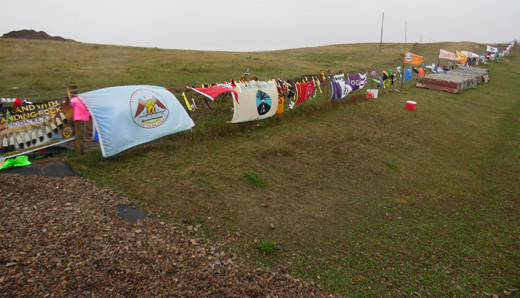
Signs of the permanence of the settlement include systems to distribute water and cooked meals to thousands, a growing school system, a medical center complete with an ambulance, tents being replaced with makeshift shelters and even elementary construction sites being prepared for buildings that can keep people warm in the winter.
Like any other permanent settlement, arrangements have been made for the safety and security of the residents. When we arrived cars lined the southern entrance to the camp waiting to be cleared for entry by members of the voluntary security team. At night the security details are larger than those on duty during the day.
The 12-passenger van I arrived in was driven by a member of the American Indian Center of Chicago. We had only four passengers though, because the vehicle was filled to the brim with supplies the Center was sending to the Sacred Stone Camp. The non-profit Chicago group works to develop relations among the Native people living in that city and between them and the rest of the population.
The Sacred Stone camp is separated from the Standing Rock Sioux reservation by the Cannonball River to its north and west. In addition to food distribution systems there are in place other systems to ensure delivery to residents of wood, clothing and other supplies. Porta Johns are set up throughout the camp and are cleaned on a regular basis. Trash disposal systems that include recycling and the set-up of compost piles are in place. Teams of volunteers patrol the campsites to make sure they are kept clean.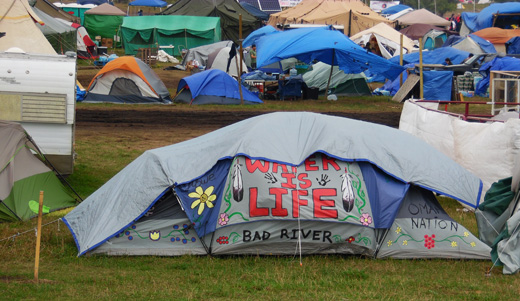
There is one huge central or primary kitchen complete with propane burners. Volunteers cook things like buffalo stew and corn soup, and the cooked meals are distributed to people throughout the campsite. Free breakfasts, lunches and dinners are made available this way.
The primary kitchen is actually a series of connected canopies attached to wooden structures. Organizers in the kitchen go around making sure volunteers are keeping their hands clean and that they are following proper health protocols while preparing the food. Anyone who has anything to do with handling food in any way is required to use one of the handwashing stations set up around the primary kitchen.
Firewood is also centrally stored within the camp, with a steady stream of people bringing in freshly chopped new wood. The supplies are adequate to keep the night fires going throughout the encampment.
Temperatures have already plunged into the thirties in the area, so warmth at night is imperative.
The school at the site is called the Defenders of Water School. Army tents and tepees are used as classrooms. Besides brushing up on writing and reading children are taught native crafts.

We camped in the northern section of the settlement with the Hunkpappa, what the Standing Rock Sioux call themselves. This camp, which was on a hill, had a red horse trailer in the center, surrounded by many tents. It has its own makeshift kitchen but the meals are not as fancy as those in the primary kitchen. Here it was mainly rice and beans.
The big fire in this encampment, where they used an old tractor rim to keep the flames under control, was a necessity. It was windy and cold on the hill. Proper setting up of one’s tent is also an absolute necessity. More than one in the encampment woke up when their rain-soaked tents collapsed on top of them.
The cold weather, as noted, has already started in North Dakota and the water protectors have started preparing for winter. People like David “Flow” Rodriguez, a camper who came here from Chicago, has never seen how harsh a North Dakota winter can be. “We’re scared of getting hit with frostbite and pneumonia and all of the like,” he told us.
They have requested winter camping supplies as many of the tents and structures are not yet ready for the harsh Dakota winter. Wood burning stoves have been donated, but not enough to keep the entire camp warm.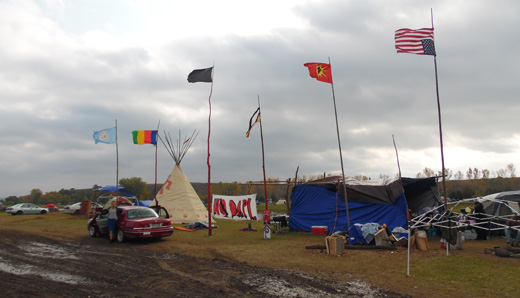
“Things have been kind of hectic since I got here around 24 days ago, but I consider it to be home now,” Rodriguez said.
A group has set up camp just across from the burial ground so the company doesn’t disturb the sacred site. The Sacred Ground Camp is much smaller than the main camp. While the members of the camp declined to give us the number of people residing there, a reasonable estimate, based on observation, is about 50.
The small group at the Sacred Ground Camp has to work night and day, only getting 2 or 4 hours of sleep. Guarding the camp and protecting against wind are big jobs and will get bigger, they say, when the sub-zero temperatures come this winter.
The “water protectors” are planning to construct buildings, wigwams and more tepees to enhance their ability to stay warm this winter.
The many Native nations represented at the camp come from Canada, Mexico and South America. Support comes, too, from non-indigenous people – black, white and Asian.
Acts of civil disobedience at the campsites include a mix of prayer and direct actions. Prayers are enunciated in the native tongue of the Lakota people. Native American culture is in evidence everywhere with songs sung and stories told over intercoms during the day. (story continues after video)
Not everything has gone peacefully. Contractors hired by the pipeline company at one point used dogs to attack women and children. The National Guard has been brought in by the governor of North Dakota and a concrete blockade has been set up on Highway 1806.
Despite the protests, the Dallas-based pipeline company says it intends to complete the project.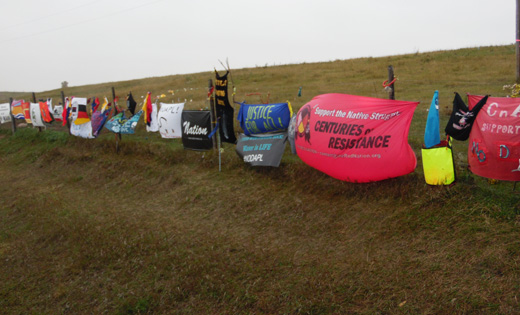
The residents of the Sacred Stone Camp are determined, however, and there are some glimmers of hope. Three federal agencies are reviewing the construction-permitting process, causing a temporary halt to work on a section of the pipeline near here.
The campfires at night provide some of the warmth needed during the cold nights so people can sit and discuss with one another this and other matters. They know, however, that given North Dakota’s brutally cold winters they will need more than campfires to get them through. They are going to need all the support they can get.
Those who would like to help out can buy items on their amazon wish list or on their site supply list. If you would like to get involved then checkout the “#NoDAPL Solidarity” website to find an action near you. There is a legal fund to donate to at the “Red Warrior Camp Legal Fund.”
Note: All photos and video taken by Earchiel Johnson/PW.










